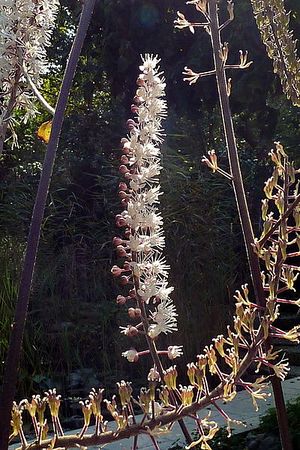Note: This is a project under development. The articles on this wiki are just being initiated and broadly incomplete. You can Help creating new pages.
Actaea racemosa - Black cohosh
Black Cohosh Actaea racemosa has been used by Native Americans for more than two hundred years, after they discovered the root of the plant helped relieve menstrual cramps and symptoms of menopause. These days it is still used for menopausal symptoms such as hot flashes/flushes, irritability, mood swings and sleep disturbances.
Contents
Uses
Tentex forte, Muscle & Joint Rub, Impotency & Erectile dysfunction, Diarrhoea, Pharyngitis & Sore Throat, Toothache, Pyorrhea, Common Cold, Childhood apraxia of speech, Delayed Speech Development.
Parts Used
Chemical Composition
Analysis has shown a brown, resinous, acrid substance, insoluble in potassium hydroxide and probably containing pelletonin, two oils soluble in potassium hydroxide - one dark brown and acrid, the other yellow - tannin, gum, potassium sulphate and carbonate, potassium chloride, calcium phosphate and carbonate, silica, alumina, lignin, etc. An alkaloid, Pyrethrine, yielding pyrethric acid, is stated to be the active principle.[1]
Common names
| Language | Common name |
|---|---|
| Kannada | |
| Hindi | Akarkara |
| Malayalam | Akkarakaaram |
| Tamil | |
| Telugu | |
| Marathi | NA |
| Gujarathi | NA |
| Punjabi | NA |
| Kashmiri | NA |
| Sanskrit | Akarkarabh |
| English | Pellitory |
Habit
Identification
Leaf
| Kind | Shape | Feature |
|---|---|---|
| Smooth | Alternate, Pinnate | The leaves are with deeply-cut segments |
Flower
| Type | Size | Color and composition | Stamen | More information |
|---|---|---|---|---|
| Unisexual | 14-18cm long | Yellow, Circular | Each bears one large flower the disk being yellow and the rays white, tinged with purple beneath. |
Fruit
| Type | Size | Mass | Appearance | Seeds | More information |
|---|---|---|---|---|---|
| Syncarp (sorosis), subglobose or ellipsoid with long echinate processes, orange when ripe | seeds many, ovoid. | {{{6}}} |
Other features
List of Ayurvedic medicine in which the herb is used
- Vishatinduka Taila as root juice extract
Where to get the saplings
Mode of Propagation
How to plant/cultivate
Aracemosa grows in dependably moist, fairly heavy soil. It bears tall tapering racemes of white midsummer flowers on wiry black-purple stems, whose mildly unpleasant, medicinal smell at close range gives it the common name "Bugbane"[3]
Commonly seen growing in areas
Mediterranian, Himalayas, Arabian countries.
Photo Gallery
References
External Links
- Pages that are stubs
- Ayurvedic Herbs known to be helpful to treat Tentex forte
- Ayurvedic Herbs known to be helpful to treat Muscle & Joint Rub
- Ayurvedic Herbs known to be helpful to treat Impotency & Erectile dysfunction
- Ayurvedic Herbs known to be helpful to treat Diarrhoea
- Ayurvedic Herbs known to be helpful to treat Pharyngitis & Sore Throat
- Ayurvedic Herbs known to be helpful to treat Toothache
- Ayurvedic Herbs known to be helpful to treat Pyorrhea
- Ayurvedic Herbs known to be helpful to treat Common Cold
- Ayurvedic Herbs known to be helpful to treat Childhood apraxia of speech
- Ayurvedic Herbs known to be helpful to treat Delayed Speech Development
- Herbs with Dried Roots used in medicine
- Herbs with Leaves used in medicine
- Herbs with Flower used in medicine
- Herbs with common name in Hindi
- Herbs with common name in Malayalam
- Herbs with common name in Sanskrit
- Herbs with common name in English
- Habit - Procumbent herb
- Index of Plants which can be propagated by Seeds
- Index of Plants which can be propagated by Cuttings
- Herbs that are commonly seen in the region of Mediterranian
- Herbs that are commonly seen in the region of Himalayas
- Herbs that are commonly seen in the region of Arabian countries
- Herbs



